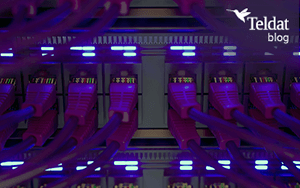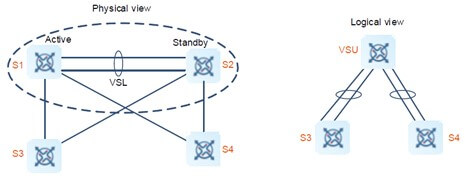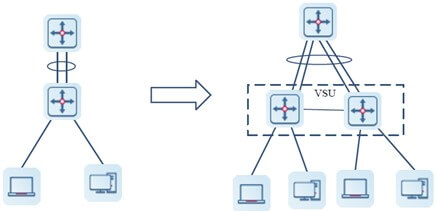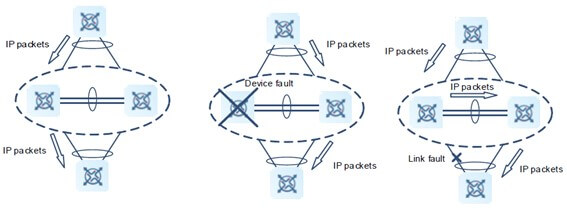 This blog post is the first in a series in which we will analyze the most notable technologies that we should take into account when selecting switches. Its aim is not to give a comprehensive description or follow any “didactic” order. One of the main characteristics of professional switches is the feature known as stacking, grouping or virtualization.
This blog post is the first in a series in which we will analyze the most notable technologies that we should take into account when selecting switches. Its aim is not to give a comprehensive description or follow any “didactic” order. One of the main characteristics of professional switches is the feature known as stacking, grouping or virtualization.
Different manufacturers refer to this feature in different ways: “Virtual Switching Unit”, “Virtual Switching System”, “Virtual Switching Framework”, “Stacking”…If we were to simplify matters to the extreme, we could describe this feature as the possibility to “combine” the capabilities of several switches to obtain increased performance or aggregated functionalities. While simple, this description is very incomplete (as we’ll see further on). There is a type of “stacking” based on back panel technology. This is a very specific solution heavily oriented towards very high performance and, as such, we are not going to be covering it in depth in these blogs.
How does a Virtual Switch work?
Using certain elements:
- Physical connections
- Identifiers
- Roles
- Priorities
…we manage to create a “Virtual Switching Unit” (VSU) that combines the features of the physical switches that make up the group.
Regarding physical connections, sometimes they’re established via cables and special interfaces. Other times, they are established using certain interfaces that belong to the switch itself (often high-speed fiber-optic interfaces). The Virtual Switch must be identified. One way to do so is using a group identifier or domain. When this technique is used, all the switches belonging to the same Virtual Switch must share the same domain identifier. Within the same domain, another identifier must discriminate the devices that make up the group.
Once devices are connected, proprietary protocols from each manufacturer are able to “unite” with the Virtual Switch. This makes it possible to combine the features of all physical devices. During this process, each device acquires a role. One device (called “Active Device”) assumes the main role and is in charge of governing and controlling the whole Virtual Switch.
The remaining roles and the priorities mentioned earlier determine which device becomes the Active Device if the previous one fails or is unavailable. Understanding the Virtual Link is important to learn how these Virtual Switches work. This is the name given to the permanent connection between devices (where data traffic and control traffic flows).
In the following figure:
The Virtual Switch is made up by uniting S1 and S2. The virtual link is established between both (VSL, in the figure). From a logical perspective, the end result is the one that appears on the right.
Advantages of the Virtual Switch
The best way to understand the Virtual Switch concept is to learn the benefits and advantages it brings.
Cost efficiency
This is achieved by allowing the expansion of network capabilities, safeguarding the investments made until then.
When it comes to expansion possibilities, they can be any of the following:
- Port expansion: for cases in which the current port density cannot meet the needs for growth.
- Increasing packet switching capabilities: multiplied by two when the switches belonging to the same Virtual Switching Unit (VSU) are doubled.
- Increasing bandwidth capabilities in uplink: multiplied by two when the switches belonging to the same Virtual Switching Unit (VSU) are doubled.
Easier operations and management
The use of Virtual Switching Units (VSU) allows to simplify the network structure. It saves management work and complexity.
Device management: Managing several devices belonging to the same VSU can be done through a single device.
Network simplification: In a scenario where several access switches are connected to a pair of aggregation switches, if these aggregation switches are part of the same VSU, complex topologies deriving from links between each access switch and aggregation switch are no longer necessary. In addition, Multi Spanning Tree (to eliminate loops) or VRRP (to manage device redundancy) protocols also become unnecessary.
Improved reliability
Virtual Switching Units (VSU) can be used to easily implement redundancy mechanisms for devices and links.
Conclusions on Virtual Switches
The stacking or virtualization of switches (available in professional switches) is a very powerful tool to deploy in local area networks. In many cases, it provides more robust and smooth solutions than those based on complex protocols. This is an important factor for network engineers that must plan and design the deployment of LAN networks and the necessary investments in equipment.
The range of Windbit switches includes models equipped with a flexible and powerful stacking/virtualization solution, capable of competing with the most sophisticated devices in the market.






























